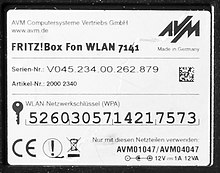
Back Wi-Fi Protected Access Afrikaans وصول محمي للشبكات اللاسلكية Arabic Təhlükəsiz Wi-Fi girişi Azerbaijani WPA BS Wi-Fi Protected Access Catalan Wi-Fi Protected Access Czech Wi-Fi Protected Access German Wi-Fi Protected Access Esperanto Wi-Fi Protected Access Spanish WPA Estonian

Wi-Fi Protected Access (WPA), Wi-Fi Protected Access 2 (WPA2), and Wi-Fi Protected Access 3 (WPA3) are the three security certification programs developed after 2000 by the Wi-Fi Alliance to secure wireless computer networks. The Alliance defined these in response to serious weaknesses researchers had found in the previous system, Wired Equivalent Privacy (WEP).[1]
WPA (sometimes referred to as the TKIP standard) became available in 2003. The Wi-Fi Alliance intended it as an intermediate measure in anticipation of the availability of the more secure and complex WPA2, which became available in 2004 and is a common shorthand for the full IEEE 802.11i (or IEEE 802.11i-2004) standard.
In January 2018, the Wi-Fi Alliance announced the release of WPA3, which has several security improvements over WPA2.[2]
As of 2023, most computers that connect to a wireless network have support for using WPA, WPA2, or WPA3.
- ^ "Understanding WEP Weaknesses". Wiley Publishing. Archived from the original on 2010-03-18. Retrieved 2010-01-10.
- ^ "Wi-Fi Alliance® introduces security enhancements | Wi-Fi Alliance". www.wi-fi.org. Retrieved 2018-01-09.